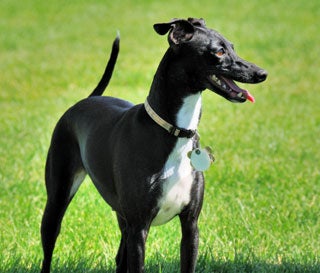Learn about dog breeds
Detailed information & photos on over 190 different breeds
Description
When you think of the Italian Greyhound, you might immediately think of the famous racing Greyhound. However, this breed has some qualities that make it quite different from the racing breed. This dog has a thick coat with a long head. They also have a thin pointed muzzle. This dog's ear shape is pointed and they stand up when nervous or happy. Another characteristic of this day is that they have a different coloring compared to the racing Greyhound, you will find these dogs in solid colors of blue, black, slate, cream or gray. Some varieties even have white markings.
This dog is the smallest out of the sight hounds. Their gait is high stepping and has skip when running or walking. Even though they do not race they still have the ability to run quickly. This breed can reach rates of 25 MPH when they do run.
Coat Description
The Italian Greyhound's coat is short, silky and can be black, dark blue, grey, and slate. This dog's coat is easy to groom and maintain.
History
It is believed that this dog originated in the Egyptian tombs approximately 6000 years ago. They were first found in Europe when the Phoenicians brought them over which were then trained by the Romans. The Italian Greyhound has been found in artifacts in Pompeii, Italy as a companion dog and hunting dog.
Temperament
This dog is a great pet for any household. They are calm and gentle towards others. They love to be around people and aim to please their master. As long as you provide enough exercise for this breed, this dog will not harm your furniture or other possessions due to boredom.
These dogs love to play and are smart so they make great pets for children. Since they are gentle, they understand that they cannot be rough with smaller kids in the home. It is important to socialize your Italian Greyhound as a puppy so the he understands what is expected when playing with small children. These dogs can become frightened by loud sounds and will shy away from family members who are rambunctious. It is important to teach children as well that they must be careful around this dog so he doesn't become timid.
If you are interested in a guard dog, this dog may not be the perfect pet for you because they naturally love towards all people. However, if you are only looking for a watchdog this is a great pet to have around the house? They will bark at strangers and unfamiliar sounds.
Health Problems
The Italian Greyhound is a hardy dog even though they appear meager. After 18 months, these dogs have strong and muscular legs which do not break as easily as do as a puppy. Even though these dogs are quite healthy there are some conditions that you need to know when having this dog as a pet. Their legs do mature after 18 months but these dogs are still prone to fractures if exercised in rough terrain or the dog trips. They also can suffer from a slipped stifle, which is a stress fracture and slipped vertebrae. Hip Dysplasia is common in all large dogs and is a type of arthritis that is painful and makes it hard for the dog to walk. Other conditions include, Progressive Retinal Atrophy (PRA), Epilepsy, and Anesthetics.
Grooming
The Italian Greyhound is easy to groom. They have short hair and it is usually silky. This means that you will have minimal shedding and you won't have to brush through tangles. You should only bathe your dog when he is visibly dirty. Washing your dog too often can take out the natural oils that the coat has which gives them that luster and silky soft hair. Nails also need to be trimmed when needed. Teeth need to be brushed by a professional to keep tartar build up at bay.
If you take your dog to the park or wooded area, make sure you check for ticks and fleas. It is important for the health of your dog and in keeping your home flea free. Speak to your veterinarian about preventative measures.
Exercise
Exercise is important to the Italian Greyhound, it keeps the dog happy, healthy and out of trouble inside the home. These dogs are energetic and need an outlet for this reason. Make time to take your dog out for a run or long walk. They prefer running so if you have a dog park, which has enclosed fences, this would be a great place for the Italian Greyhound. Be careful when letting your dog play with other dogs because they can receive a fracture this way.
Training
This intelligent dog can be trained quite easily. You will need to start training as a puppy so the dog does not pick up bad habits that are harder to rectify. It is important to be affectionate toward your pup during training because you don't want your Italian Greyhound to be timid or shy.
Socialize your pup with other dogs and teach him how to play gentle. This is also true of socializing with children. Since they are energetic and playful they need to understand when it might be too much for a child. Children need to be taught to speak in a regular tone voice because loud pitch voices can startle and make the dog run and hide.
Housebreaking your Italian Greyhound can be difficult especially since they have small bladders. You need to wait until the dog is at least 10 weeks old. You don't want to wait past 12 weeks because it can make it much harder to train. Many owners of Italian Greyhounds paper train or litter box train their dogs.
Advertise | Privacy Policy | Terms of Use | Contact Us © Copyright 2004-2024 PupCity.com. All rights reserved.
